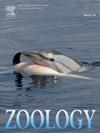Cytogenetic insights into Sosippinae (Araneae, Lycosidae) reveal pronounced diploid number reduction in Aglaoctenus and elevated number of rDNA loci in two unrelated species
IF 1.6
3区 生物学
Q2 ZOOLOGY
引用次数: 0
Abstract
Spiders represent a fascinating group for studying chromosomal evolution due to their dynamic karyotypes, which reveal significant differences even between closely related taxa. Lycosidae, one of the most species-rich families of spiders, has its major relationships well stablished, though minor interspecific relationships remain poorly understood. Here, we analyzed chromosomal data from four species belonging to Aglaoctenus and Diapontia, two genera within the subfamily Sosippinae, to discuss the evolution of chromosomal traits within this lineage. For karyological analysis, we employed Giemsa staining, C-banding, Ag-NOR staining, and 28S rDNA FISH to identify key chromosomal characteristics and the distribution of repetitive elements. Both A. oblongus and D. uruguayensis exhibited 2n♂=28, X1X2, with acro/telocentric morphology, hypothesized to represent the ancestral condition for Lycosoidea. However, regarding the 28S rDNA chromosome mapping, these species revealed an unusually high number of loci with eight chromosome clusters in A. oblongus and a polymorphic condition in D. uruguayensis (10–14 signals), underscoring the utility of additional techniques for detecting specific chromosomal regions. Interestingly, A. castaneus and A. lagotis displayed a more derived karyotype, characterized by 2 n♂= 14, X1X2 and acro/telocentric morphology, with the sex chromosomes (X1 and X2) smaller than the autosomes. Taken together, these data suggest that, following the diversification of Aglaoctenus, a significant reduction in diploid number occurred, affecting only the autosomes. These findings encourage further cytogenetic research within Sosippinae and support the use of these data in future phylogenetic studies.
从细胞遗传学的角度分析,蜘蛛科、石竹科的Aglaoctenus的二倍体数量明显减少,而两个不相关的物种的rDNA位点数量增加
蜘蛛是研究染色体进化的一个迷人的群体,因为它们的动态核型揭示了甚至在密切相关的分类群之间的显着差异。雪蛛科是种类最丰富的蜘蛛家族之一,它的主要关系建立得很好,尽管次要的种间关系仍然知之甚少。本文分析了Sosippinae亚科两属Aglaoctenus和Diapontia四种的染色体数据,探讨了该谱系中染色体特征的进化。在核学分析方面,我们采用Giemsa染色、c带、Ag-NOR染色和28S rDNA FISH来确定关键的染色体特征和重复元件的分布。A. oblongus和D. uruguayensis均表现为2n♂= 28,x1x2,具有跨/远心形态,假设代表了lycoso总科的祖先条件。然而,关于28S rDNA染色体定位,这些物种在a . oblongus和D. uruguayensis中显示出异常高的位点数量和8个染色体簇,在D. uruguayensis中显示出多态性(10-14个信号),强调了检测特定染色体区域的额外技术的有效性。有趣的是,castaneus和a . lagotis的核型更具衍生性,其特征为2 n♂= 14,X1X2和跨/远心形态,性染色体(X1和X2)小于常染色体。综上所述,这些数据表明,随着Aglaoctenus的多样化,二倍体数量显著减少,仅影响常染色体。这些发现鼓励了进一步的细胞遗传学研究,并支持这些数据在未来系统发育研究中的使用。
本文章由计算机程序翻译,如有差异,请以英文原文为准。
求助全文
约1分钟内获得全文
求助全文
来源期刊

Zoology
生物-动物学
CiteScore
3.90
自引率
0.00%
发文量
37
审稿时长
70 days
期刊介绍:
Zoology is a journal devoted to experimental and comparative animal science. It presents a common forum for all scientists who take an explicitly organism oriented and integrative approach to the study of animal form, function, development and evolution.
The journal invites papers that take a comparative or experimental approach to behavior and neurobiology, functional morphology, evolution and development, ecological physiology, and cell biology. Due to the increasing realization that animals exist only within a partnership with symbionts, Zoology encourages submissions of papers focused on the analysis of holobionts or metaorganisms as associations of the macroscopic host in synergistic interdependence with numerous microbial and eukaryotic species.
The editors and the editorial board are committed to presenting science at its best. The editorial team is regularly adjusting editorial practice to the ever changing field of animal biology.
 求助内容:
求助内容: 应助结果提醒方式:
应助结果提醒方式:


